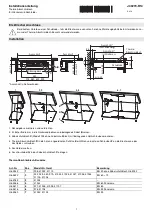
6512
MECHANICS MAINTENANCE
Every year a mechanic or service technician should perform the following inspection and
carry out the respective maintenance as required:
Warning: FOR SAFETY, TURN OFF SLICER AND DISCONNECT ELECTRICAL CORD.
1.
BELT DRIVE -
This drive features a multi-ribbed high performance belt for
long trouble-free service. Inspect belt for proper tension. If glazed or
excessively worn, replace. A tensioning device automatically allows for normal
belt wear-in and stretching. However, if additional tension is required, it may
be obtained by turning adjustment nuts (Fig. 3 [21]) clockwise on take-up rod
(Fig. 3 [26]) which will further compress the tensioning spring. As a guideline,
the compressed length of the spring should be approximately 7/8".
2.
CARRIAGE -
Check for free smooth operation of last slice device and for
smooth travel of carriage arm (Fig. 4 [23]). Check for excess backlash
between slide bearing (Fig. 4 [50]) and carriage slide (Fig. 4 [55]). The correct
lash (clearance) required for smooth carriage operation is obtained when a
very slight lash or movement can be detected. Too much lash can result in the
carriage striking and damaging the knife edge. Too little lash results in binding
and a loss of smoothness in carriage travel. Lash is adjusted by loosening
locknut (Fig. 4 [47]) and turning nylon tipped stud (Fig. 4 [48]) clockwise to
reduce lash and counterclockwise to increase lash. Tighten locknut while
holding nylon tipped stud stationary with a screwdriver so it does not move.
Grease only the side of the carriage slide (Fig. 4 [55]) on which this nylon
tipped stud screw slides. General guidelines: tighten screw until snug and then
loosen 1/8 turn and tighten locknut as described above
3.
LUBRICATION
&
FUNCTION CHECK -
General lubrication should be
performed in accordance with the lubrication instructions in Fig. 2. During this
lubrication sequence, be sure to check for free operation and movement of
related parts as well as for excessive wear and looseness of various parts. Be
sure to check all handles and knobs for tightness.
4.
KNIFE -
Check knife edge to see that it has been properly sharpened. If there
is any evidence of incorrect sharpening procedure, such as excessive honing,
alert owner and operator.
Page 8







































